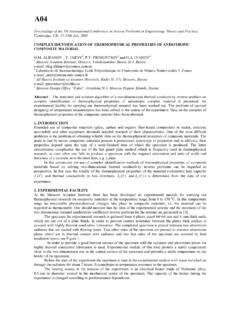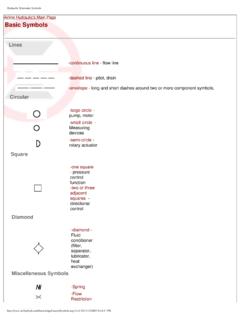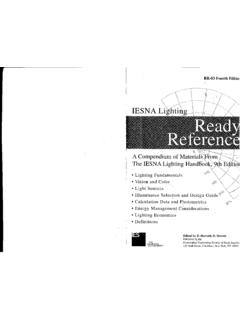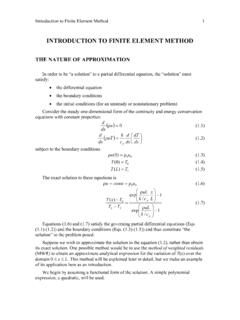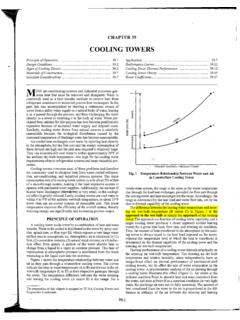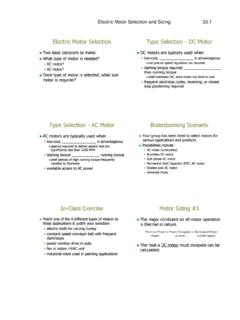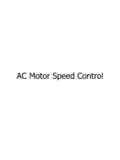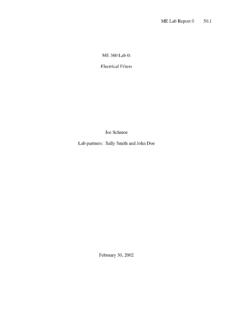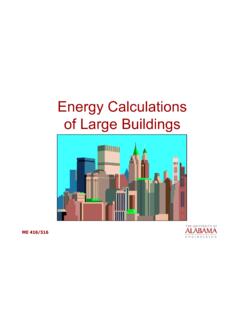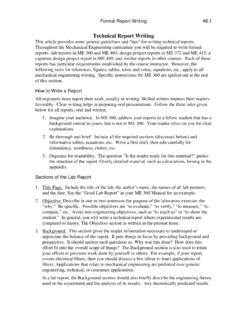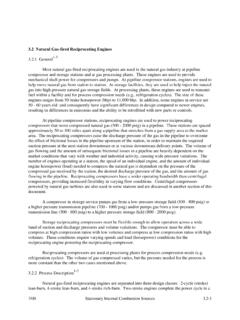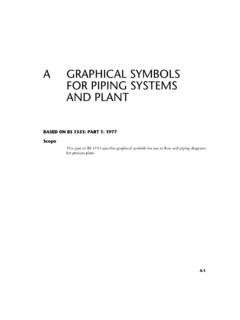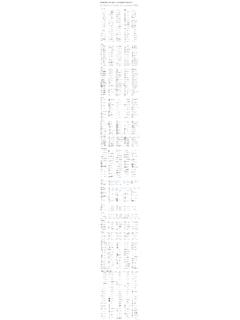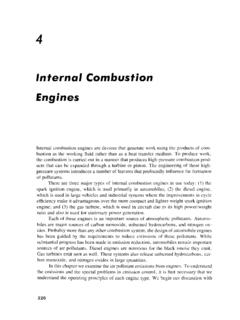Transcription of Boilers - University of Alabama
1 ME 416/516ME 416/516 Motivation Boilers , were a major part of the Industrial Revolution beginning about 1700. They are major consumers of industry and building energy consumption today. Industry: Boilers are used for power generation, process heat ( , refineries, petrochemicals, paper mills, tire manufacturing, etc.) and heating. In buildings, Boilers are used for steam primary heat, terminal reheat systems, water heating and absorption 416/516ME 416/516 Introduction There is a tremendous variation in boiler design and size- ranging from home heating size of capacity less than 100 Ibm/hr of steam to utility Boilers in excess of 10 million Ibm/hr. The focus here will be on Boilers sized in between these two extremes, which is also where there is the greatest diversity of design. In order of increasing capacity, three boiler types are the fire-tube, water-tube and waterwall 416/516 Fire-Tube Boiler (~1800) The fire tube boiler, the oldest design, is made so the products of combustion pass through tubes surrounded by water in a shell.
2 The furnace/flame volume can either be inside or external to the shell that contains the water. The upper steam capacity of fire tube Boilers is about 20,000 Ibm/hr, and the peak pressure obtainable is limited by their large shells to about 300 psi. Fire-tube Boilers are used for heating 416/516 Cleaver-BrooksHorizontal, four-pass, forced-draft fire-tube boilerME 416/516 Water-Tube Boiler (1867) A water-tube boiler is one in which the products of combustion pass around the outside and heat tubes containing the water. The water tube diameter is much smaller than the shell diameter of a fire-tube boiler, so much higher pressures can be obtained, well over 2000 psi. The furnace and boiler tube area must be surrounded by a heavily insulated refractory wall to prevent heat transfer through the boiler walls. The refractory lining is a high maintenance 416/516 Type FM integral-furnace package boilerBabcock and WilcoxME 416/516 D-type water-tube boiler Flex-tube water-tube boilerEnglish Boiler DrumMud DrumWater TubesFurnaceME 416/516 D-type water-tube boilerABBME 416/516 BryanExterior of small water-tube package boilerME 416/516 Package Boiler All but the largest Boilers used for heating and industrial purposes are packaged Boilers .
3 They are factory-built and shipped whole or in modular components to the customer. Many are constructed in an elongated shape that will fit through large building doors with minimal field adjustment 416/516 Water-tube package boiler under constructionRileyME 416/516 BryanLarge package boiler installationME 416/516 Nebraska BoilersLarge package boilerME 416/516 Waterwall Boiler All large and many intermediate-sized Boilers are water-tube boiler with a boiler section that consists of closely-spaced water tubes covering the furnace wall. The waterwall boiler design allows much lighter, less expensive walls by having the waterwallsform an integral part of the boiler wall so that the wall is water cooled. If so equipped, the superheater and reheaterare separate sections hanging above the main furnace 416/516 Membrane wall of waterwall boilerMembrane BarWall TubeInsulationMetal LaggingME 416/516 Waterwall under constructionME 416/516 Steam DrumWaterwallsAux.
4 BurnersSpreader StokerSuperheaterCyclone ScrubbersStirling Boiler-A small waterwall boiler for burning solid material such as bark, chips or 416/516 Combustionin Boilers There are four importantfactors that control com-bustion in boiler furnace:1. Air supply- Need adequate air for complete combustion. The rating (capacity) of a boiler can be increased by supplying additional air (think of the effect of bellows on a small fire). Too much air can result in excessive stack 416/516 Combustion Factors2. Mixing of fuel and air- fuel and air molecules must be brought into close proximity in order for combustion to occur. The larger the fuel "particles" the greater the difficulty in achieving good mixing- easiest for gaseous fuels, more difficult for liquid fuels and pulverized solids, most difficult for stoker coal, bark or large trash 416/516 Combustion Factors3. Temperature- all combustion reactions proceed exponentially more rapidly with increasing T Temperatures too low: incomplete combustion, waste fuel unburned hydrocarbons and soot emissions greatly increased Temperatures too high: equipment failure, metal strength drops off quickly at high T NOxemissions greatly 416/516 Combustion Factors4.
5 Combustion time- fuel "particles" must be given sufficient time (residence time) in the furnace to achieve complete combustion. Like fuel/air mixing, the required residence time is least for gases and most for large solid fuels: Gases and fine liquid sprays- 10 - 20 ms burnout Pulverized fuel (coal, sawdust)- 1 s burnout Stoker coal, bark, wood waste, trash- 10 s of minutesME 416/516 Fuel Considerations Natural gas and fuel oil burners. The fuel is brought to a burner at elevated pressure and jetted (gas) or sprayed (oil) into the furnace. Relatively simple and low 416/516 Large Oil BurnerABBME 416/516 Coal/SolidFuel Firing There are a considerable number of ways to feed coal in use, including, hand- fired Boilers , chain or traveling grate stokers, vibrating grate stokers, underfeed stokers, spreader stoker, pulverized coal Boilers , cyclone Boilers and fluidized bed coal furnaceME 416/516 Stoker Boilers The term stoker implies a boiler that automatically feeds (or " stokes ) the boiler.
6 Stoker coal size is typically inches maximum with less than 30% under 416/516 Traveling or Chain Grate Stokers Traveling or chain grate stokers feed coal out onto a rotating metal belt that supports the fire. Coal is fed from a hopper. Grate speed is automatically controlled to maintain desired steam pressure. Burning progresses as the belt moves from front to back of furnace. Combustion is essentially complete at the back end of belt, and ash is dumped off into an 416/516 Traveling GrateWater-Cooled Grate ElementsME 416/516 Vibrating Grate Stoker Vibrating grate stoker is similar to a traveling grate, except that instead of being on a continuous loop, grate sections are sloped downward and periodically vibrate to cause fuel particle movement from front to back. Vibration frequency is controlled to obtain desired steam pressure/ heat 416/516 Water-Cooled Vibrating Grate BoilerCoal hopperOverfireair nozzlesVibration generatorUnderfireair supplyTo ashpitWaterwallsVibrating grateFuelME 416/516 Underfeed Stokers So named because they use rams to force the coal up underneath the burning fuel bed.
7 Grates are designed to flex up and downs to break up fuel bed and prevent "clinker" formation. Action of feed rams and fuel bed flexing cause fuel to move from front to back of furnace. Underfeed stokers range in size from small home heating Boilers to large industrial size. Underfeed stokers are very good at burning high volatile coal with a high turn-down 416/516 Underfeed Stoker BoilerCoal hopperFeeder rams and actuatorFuelME 416/516 Spreader Stokers Fed by a rotating bladed wheel that throws the coal out over the grate. Spreaders stokers are more expensive than other stokers in small sizes, and are more expensive than pulverized coal Boilers in large sizes (over 500,000 Ibm/hr of steam) but are very common in the intermediate (large industrial) size range. Compared to previous stokers, more fuel burning occurs in suspension- that is, in the air as the fine particles are slung out over the fuel 416/516 Spreader Stokers (Cont d) Because of feeding method, more small particles and fly ash are carried up with the exhaust.
8 Particles trapped up in boiler, economizer, air preheater and dust collectors are recycled for better combustion efficiency and reduced particulate emissions. Grates are of several types. Some are traveling or vibrating to move fire from back to front of furnace and dump ash over the front into an ashpit. Others grates periodically are turned over to collect 416/516 Spreader Stoker BoilerAirborne fuelFuel hopperFuel feederME 416/516 Adjustable spill plateCoal hopperReciprocating feed plateSpreader rotorReciprocating Coal FeederME 416/516 Coal FeedersME 416/516 Pulverized Fuel Boilers Pulverized coal Boilers fire finely powdered coal, typically with an average particle size of about 25 m ( in). Coal burns in suspension, like the combustion in an oil- or gas- fired boiler. Coal is pulverized in some type of large mill Pulverized coal is fired out into the furnace volume using burners that look somewhat like oil or gas 416/516B&WPyrites trapWindboxClassifierRaw coal feederDriving mechanismBalls (~18-in)Ball Mill Coal PulverizerME 416/516 Grinding tableGrinding rollerNozzle ringCoal feed inletPC outletPrimary air inletRejects hopperPlanetary gear driveClassifier housingDB RileyRoller Mill Coal PulverizerME 416/516 Oil/gas lighterWaterwallCoal impellerRefractory throat with studded tubesWindboxSecondary air register doorPulverized Coal BurnerME 416/516 Water-wall With Four BurnersME 416/516 Low-NOxPulverized Coal BurnerDB RileyME 416/516PC vs.
9 Stoker Boilers : Advantages/Disadvantages Advantages of PC vs. stoker Boilers : much quicker response to changing loads lower excess air/higher efficiency easily adaptable to automatic control can burn wide variety of coals Disadvantages of PC vs. stoker Boilers : more expensive (at least for smaller capacities) require more skilled personnel require better emission control (particulates) require more energy to pulverize fuelME 416/516 Coal Combustion We have examined the combustion of fuels for which we have a molecular formula, , C3H8or CH4 Coal is characterized by a mass based formula resulting from an ultimate analysis. Ultimate analysis gives the elemental compositionME 416/516 Ultimate Analysis The ultimate analysis is a measurement of a coal sample that yields the mass percent of each element tested, plus the percent of ash in the coal. The primary elements are C, H, O, N and S. The ash is the noncombustible portion of the coal.
10 There are other elements present in lesser quantities, some of which are hazardous, such as Cl, V, and Hg, but the CHONS are the important elements for combustion 416/516 Conversion from a Mass to a Mole Basis The secret to doing coal combustion calculations is to calculate the chemical formula from the ultimate analysis data One standard method is to start with the assumption of 100 lbm of coal Recall that the relationship between mass, m, and number of moles, n, is given by the molecular weight, M, where:M = m/n or n = m/MME 416/516 Example: mass to mole basis If a coal has an ultimate analysis of H = 5%, C = 90% and Ash = 5%, find its molecular formula Assume a total mass of 100 lbm of coal The mass of carbon out of the total 100 lbm of coal is: mC= * 100 = 90 lbm carbon Number of moles of carbon is nC= mC/MC, where MC= 12, so nC= 90 lbm/12 lbm/lbmol = lbmol Similarly, mH= 5 lbm, nH= mH/MH= 5/1 = 5 lbmol We ignore the ash because it does not burnME 416/516 Coal Combustion Chemistry Once we have the number of moles of each fuel component, we can calculate the moles of air needed for complete combustion (stoichiometric reaction) just as we did earlier Once we obtain the moles of air required, we can convert that to mass of air required and calculate the air-to-fuel ratio, A/F A/F is defined as the mass of air per mass of fuel for a reactionME 416/516 Stoichiometry Terms The stoichiometric A/Fis the A/F obtained for the stoichiometric reaction (no excess air) The actual A/F is higher than the A/Fstoichto insure complete fuel burnout The stoichiometric ratiois defined.
